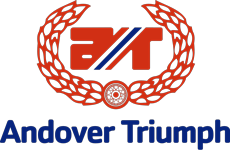1972/3 "Combat" Crankcase Modification
The 1972 engines, engine numbers 200.000 onwards, are commonly known as the "Combat" engines. This is not strictly speaking correct, as not all of them were "Combat" spec to start with, and fewer left today are still to "Combat" high-performance specification.
Engines with the "Combat" type crankcases are easy to recognize, not only by their engine number, which is in the 200.000s, but furthermore by these being the only Norton twin crankcases that do not have the big filter screw at the bottom. Plus, if they have not been modified, they have a breather tower bolted to the rear of the crankcase, between crankcase and gearbox shell.
Norton folklore wants it these engine suffered from the high performance wrung from them. The gullible Norton fans seriously believe the "Combat" engines had 65bhp, explaining why things tended to fly apart. Not only is the performance figure one of the then common publicity lies, but performance was not the problem- the crankcase was.
Another reason given was the pre-Superblend bearings digging in. Whilst German Ex-Importer Koerner told us his shop introduced Norton to the "Superblend" type bearing, I suspect the loss of oil was far more detrimental to engine life than the limited life span of the pre-Superblend bearings.
This new crankcase, and its breather arrangement, had been so cleverly redesigned for 1972 the sump was not drained properly at higher revs. Normally the problem starts from 4.000 to 4.500rpm upwards. As a result oil foam formed in the crankcase that was then thrown out of the breather, mostly unnoticed by the rider sitting in front of the breather outlet, until there was no oil left.
I have heard from owners of this engine type they never had a problem. However, having ridden a race engine on the track many years ago that- due to our ignorance of the problem at the time- sported an unmodified crankcase, I can tell you the oil literally pumped out of the breather and I put a good layer of oil onto the track, making myself highly unpopular with my fellow competitors!
As said above, the problem arises at higher revs and speeds. Not a problem for the American market at the time, with its speed limits, or the UK market with most of the roads at the time still winding though the countryside, pre-war style and standard. Very much a problem in Germany, with straight autobahns and no speed limits. The then German importer Gerd Koerner rebuilt 400 engines that year under warranty and his contract was terminated by Norton Motors because "it must be his workshop's fault".
Secretly, they knew what the problem was, and consequently issued a service information (below), no doubt written by the late John Hudson, who told me he visited Koerner to assist with the problem.
Engines with the "Combat" type crankcases are easy to recognize, not only by their engine number, which is in the 200.000s, but furthermore by these being the only Norton twin crankcases that do not have the big filter screw at the bottom. Plus, if they have not been modified, they have a breather tower bolted to the rear of the crankcase, between crankcase and gearbox shell.
Norton folklore wants it these engine suffered from the high performance wrung from them. The gullible Norton fans seriously believe the "Combat" engines had 65bhp, explaining why things tended to fly apart. Not only is the performance figure one of the then common publicity lies, but performance was not the problem- the crankcase was.
Another reason given was the pre-Superblend bearings digging in. Whilst German Ex-Importer Koerner told us his shop introduced Norton to the "Superblend" type bearing, I suspect the loss of oil was far more detrimental to engine life than the limited life span of the pre-Superblend bearings.
This new crankcase, and its breather arrangement, had been so cleverly redesigned for 1972 the sump was not drained properly at higher revs. Normally the problem starts from 4.000 to 4.500rpm upwards. As a result oil foam formed in the crankcase that was then thrown out of the breather, mostly unnoticed by the rider sitting in front of the breather outlet, until there was no oil left.
I have heard from owners of this engine type they never had a problem. However, having ridden a race engine on the track many years ago that- due to our ignorance of the problem at the time- sported an unmodified crankcase, I can tell you the oil literally pumped out of the breather and I put a good layer of oil onto the track, making myself highly unpopular with my fellow competitors!
As said above, the problem arises at higher revs and speeds. Not a problem for the American market at the time, with its speed limits, or the UK market with most of the roads at the time still winding though the countryside, pre-war style and standard. Very much a problem in Germany, with straight autobahns and no speed limits. The then German importer Gerd Koerner rebuilt 400 engines that year under warranty and his contract was terminated by Norton Motors because "it must be his workshop's fault".
Secretly, they knew what the problem was, and consequently issued a service information (below), no doubt written by the late John Hudson, who told me he visited Koerner to assist with the problem.
Modifications for Conversion from Combat to Racing Breather and Scavenge Arrangement

Timing Side
Timing Side Crankcase:
Drill 2 x 12mm holes through the crankcase at "A", taking care not to drill into the mainbearing support webs in the inside of the crankcase.
Drill 1 x 9mm hole at "B" also avoiding the mainbearing support webs.
Drill 1x 3mm hole through from the timing chamber into the crankcase below the mainbearing at point "C".
Drill 2 x 12mm holes through the crankcase at "A", taking care not to drill into the mainbearing support webs in the inside of the crankcase.
Drill 1 x 9mm hole at "B" also avoiding the mainbearing support webs.
Drill 1x 3mm hole through from the timing chamber into the crankcase below the mainbearing at point "C".
Timing Side
Timing Side Crankcase:
Drill 2 x 12mm holes through the crankcase at "A", taking care not to drill into the mainbearing support webs in the inside of the crankcase.
Drill 1 x 9mm hole at "B" also avoiding the mainbearing support webs.
Drill 1x 3mm hole through from the timing chamber into the crankcase below the mainbearing at point "C".
Drill 2 x 12mm holes through the crankcase at "A", taking care not to drill into the mainbearing support webs in the inside of the crankcase.
Drill 1 x 9mm hole at "B" also avoiding the mainbearing support webs.
Drill 1x 3mm hole through from the timing chamber into the crankcase below the mainbearing at point "C".


Timing Side (Inner)
Block off the Combat oil scavenge hole at "D" by tapping and fitting a blanking plug using Permanent Loctite.
Make a flat plate (or, alternatively, buy 06-1542 from Andover Norton) to fit onto the old magneto mounting point at the rear of the crankcase, and fit the Combat breather body to the plate. The breather body must be vertical when the engine is fitted into the frame.
Make a flat plate (or, alternatively, buy 06-1542 from Andover Norton) to fit onto the old magneto mounting point at the rear of the crankcase, and fit the Combat breather body to the plate. The breather body must be vertical when the engine is fitted into the frame.

Timing Side (Inner)
Block off the Combat oil scavenge hole at "D" by tapping and fitting a blanking plug using Permanent Loctite.
Make a flat plate (or, alternatively, buy 06-1542 from Andover Norton) to fit onto the old magneto mounting point at the rear of the crankcase, and fit the Combat breather body to the plate. The breather body must be vertical when the engine is fitted into the frame.
Make a flat plate (or, alternatively, buy 06-1542 from Andover Norton) to fit onto the old magneto mounting point at the rear of the crankcase, and fit the Combat breather body to the plate. The breather body must be vertical when the engine is fitted into the frame.

Drive Side Crankcase
Fettle or machine away the shaded area "E" just enough to expose the drilling "F" in the timing side crankcase when the crankcase halves are bolted together. This modification moves the scavenge point from the front to the rear of the engine which is important when using the engine for racing and in conjunction with the racing breather arrangement.
Make a plate to blank off the Combat breather hole at the rear of the crankcase.
With these modifications the engine breathing and scavenging are improved at racing operating speeds enabling the engine breather to discharge into atmosphere with safety. However, the first time the scavenge is used it is adviseable to route the breather pipe into a small catch tank to check if there is any excess engine oil being passed up the pipe, and if the modifications have been carried out correctly.
Make a plate to blank off the Combat breather hole at the rear of the crankcase.
With these modifications the engine breathing and scavenging are improved at racing operating speeds enabling the engine breather to discharge into atmosphere with safety. However, the first time the scavenge is used it is adviseable to route the breather pipe into a small catch tank to check if there is any excess engine oil being passed up the pipe, and if the modifications have been carried out correctly.
Drive Side Crankcase
Fettle or machine away the shaded area "E" just enough to expose the drilling "F" in the timing side crankcase when the crankcase halves are bolted together. This modification moves the scavenge point from the front to the rear of the engine which is important when using the engine for racing and in conjunction with the racing breather arrangement.
Make a plate to blank off the Combat breather hole at the rear of the crankcase.
With these modifications the engine breathing and scavenging are improved at racing operating speeds enabling the engine breather to discharge into atmosphere with safety. However, the first time the scavenge is used it is adviseable to route the breather pipe into a small catch tank to check if there is any excess engine oil being passed up the pipe, and if the modifications have been carried out correctly.
Make a plate to blank off the Combat breather hole at the rear of the crankcase.
With these modifications the engine breathing and scavenging are improved at racing operating speeds enabling the engine breather to discharge into atmosphere with safety. However, the first time the scavenge is used it is adviseable to route the breather pipe into a small catch tank to check if there is any excess engine oil being passed up the pipe, and if the modifications have been carried out correctly.









